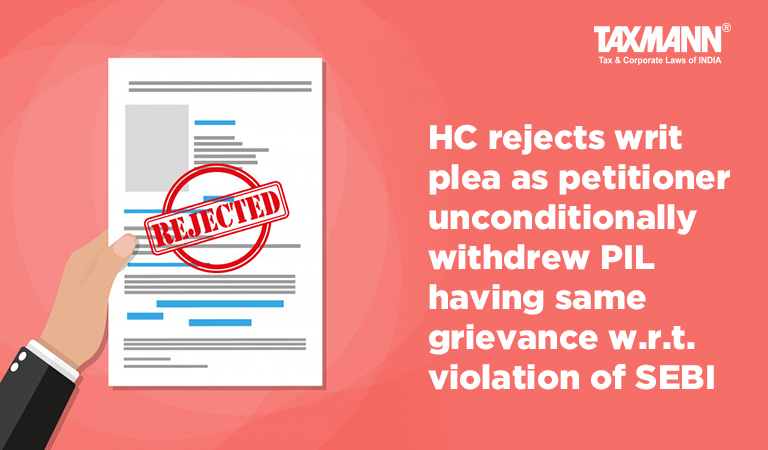HC rejects writ plea as petitioner unconditionally withdrew PIL having same grievance w.r.t. violation of SEBI
- News|Blog|Company Law|
- 2 Min Read
- By Taxmann
- |
- Last Updated on 15 July, 2021
Case details: India Awake For Transparency v. Chairman Securities & Exchange Board of India - [2021] 128 taxmann.com 5 (Karnataka)
Judiciary and Counsel Details
-
- P.S. Dinesh Kumar, J.
- R. Subramanian, Adv. for the petitioner.
- S. Ganesh, Sr. Adv. and Sandeep Huilgol, Adv. for the Respondent
Facts of the Case
In the instant case, the Petitioner had filed public interest litigation with a prayer inter alia for a writ of mandamus and to direct the respondent-SEBI to constitute a multi-disciplinary investigation team to investigate offenses alleged to have been committed by ‘A’ and his associates.
The Petitioner filed an instant writ petition against four respondents for directions against SEBI to take up investigation for violation of provisions under the SEBI Act by the respondents in three transactions set out in information and to prosecute.
The SEBI submitted that prayers made in both PIL as also writ petition were one and same so far as an investigation by the SEBI was concerned and the petitioner had unconditionally withdrawn PIL and, therefore, an instant writ petition was not maintainable on the ground of res judicata.
It was observed that a careful perusal of representations annexed to PIL and instant writ petition showed that the grievance of petitioner was one and same so far as violation of provisions of SEBI Act and Regulations were concerned.
High Court Held
The High Court held that since the petitioner had withdrawn PIL unconditionally, therefore, an instant writ petition could not be entertained, and accordingly, dismissed the writ petition.
Case Review
-
- Sarjuya Transport Services v. State Transport Appellate Tribunal, Gwaliar [1987] 1 SCC 5 (para 20) followed.
List of Cases Referred to
-
- Sheo Nandan Paswan v. State of Bihar [1987] 1 SCC 288 (para 4)
- Sarjuya Transport Service v. State Transport Appellate Tribunal, Gwaliar [1987] 1 SCC 5 (para 18).
Disclaimer: The content/information published on the website is only for general information of the user and shall not be construed as legal advice. While the Taxmann has exercised reasonable efforts to ensure the veracity of information/content published, Taxmann shall be under no liability in any manner whatsoever for incorrect information, if any.

Taxmann Publications has a dedicated in-house Research & Editorial Team. This team consists of a team of Chartered Accountants, Company Secretaries, and Lawyers. This team works under the guidance and supervision of editor-in-chief Mr Rakesh Bhargava.
The Research and Editorial Team is responsible for developing reliable and accurate content for the readers. The team follows the six-sigma approach to achieve the benchmark of zero error in its publications and research platforms. The team ensures that the following publication guidelines are thoroughly followed while developing the content:
- The statutory material is obtained only from the authorized and reliable sources
- All the latest developments in the judicial and legislative fields are covered
- Prepare the analytical write-ups on current, controversial, and important issues to help the readers to understand the concept and its implications
- Every content published by Taxmann is complete, accurate and lucid
- All evidence-based statements are supported with proper reference to Section, Circular No., Notification No. or citations
- The golden rules of grammar, style and consistency are thoroughly followed
- Font and size that’s easy to read and remain consistent across all imprint and digital publications are applied








 CA | CS | CMA
CA | CS | CMA


